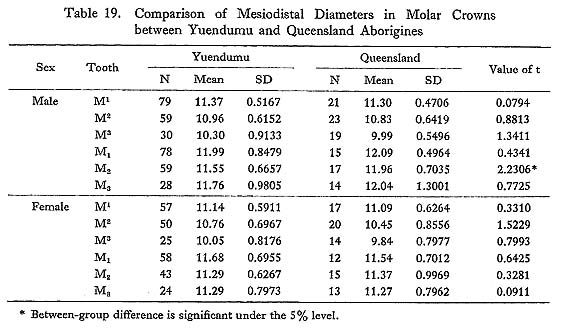4. TOOTH CROWN MEASUREMENTS
4.3. Comparison of Mesiodistal Crown Diameters between Yuendumu and Queensland Materials
|
Based on osteological as well as somatological data, homogeneity or heterogeneity of Aborigines has been discussed by many previous authors. As is well-known, Tindale and Birdsell (1941) and Birdsell (1950) proposed the so-called trihybrid theory on the basis of geographical variation of several somatological traits appearing in Aborigines. On the other hand, Howells (1937), Abbie (1951,1968, 1969), Macintosh (1963), Yamaguchi (1967), etc. stressed importance of homogeneity of this population on the basis of evidence including osteological findings. As to the dental traits of the Aborigines, as far as the present author knows, almost no comparative studies in regard to the geographical variation has been carried out on this population. Very fortunately the author had an opportunity, at the Department of Anatomy, the University of Sydney, to observe skulls derived from Queensland which were in the collections of the Australian Museum in Sydney. Because of limited time, only a few measurements on skulls as well as the maxillary and mandibular molars were carried out. In this section, comparison of mesiodistal diameters of the molar crowns between Yuendumu and Queensland materials will be made to show whether the between-group difference is significant or insignificant. One can see from Table 19 that the differences in mesiodistal crown diameters of the molars, both males and females, are insignificant between Yuendumu and Queensland groups, except for the mandibular second molars in males. The results seem to show that at least the molar crown size is almost identical in the two groups which settled far from each other.
In addition, the Yuendumu group is a little bit larger than the Queensland group in M1, M2 and M3 in males, and in M1, M2, M3, M1 and M3 in females. This seems to show that the between-group difference fluctuates at random in the molar region, and, in turn, there seems to be no definite pattern in the difference between the two groups. This fact may prove the supposition that the minor difference between the two groups occurred as an accidental fluctuation. According to Birdsell (1950), phenotypic frequencies as well as estimated gene frequencies for tawny hair, for example, are quite different between the central and eastern parts of Australia, being considerably high in the Central Australia and practically absent in Queensland. The evidence obtained from the molar crown size is, as shown above, quite different from that obtained from the hair form. Although this single example can hardly be extended to overall dental characteristics, similarity in the crown size between the two separated groups of Aborigines should be remembered for future studies. |
